Diego Maradona death: Sydney watched football genius in 1993 World Cup qualifier
Twenty-seven years ago on a piece of real estate more renowned as the home of greyhound racing, Diego Maradona left onlookers gasping in disbelief. It wouldn’t be the only time.

Socceroos
Don't miss out on the headlines from Socceroos. Followed categories will be added to My News.
Through all of his off-field faults and sins, there is simply no doubt about Diego Armando Maradona Franco’s place in the pantheon of footballing superstars. For many, he stands untouched.
He was short in stature, but had big, strong shoulders and a barrel chest. His centre of gravity allowed him to hold the ball and shake off opponents with ease. Add his speed off the mark and astute tactical brain and you had a sheer football magician.
Few headlines sum up the 60-year-old, who died on Thursday following a heart attack, better: “Touched by God on the field, touched by the Devil off it”.
Australian fans got to see the football god first hand in 1993 when he came here with the Argentine national team for a World Cup qualifier against the Socceroos at the old Sydney Football Stadium.

Picture this.
It’s a warm, sunny spring day in Sydney and the air is filled with an electricity that is making the hairs on the back of the neck stand up.
The hugely unlikely setting of Wentworth Park, while used for soccer in the 1950s, ’60s and early ’70s, but more renowned as the home of greyhound racing in Sydney, is about to be graced by one of the greatest footballers of all time.
One wonders what some of the great players of today would think about having to train on a field inside a greyhound track, let alone someone of Maradona’s stature.
As the Argentina squad, all of them in “this is business mode” bar Maradona, who had that air of nonchalance, walk on to the pitch for a training session the mass of journalists, photographers and television cameramen surge forward, elbows and arms flailing.
It was as if the fan-filled terraces of some of the great football grounds around the world had decided to invade this nondescript piece of real estate in the suburb of Ultimo all at once. It is mayhem.
Argentina was a world football super power and full of quality players but, understandably, there are eyes only for the chunky, charismatic, pocket dynamo, Maradona.
What was to follow left many of us gasping in disbelief.

‘It was a Beatles-like reception’
For just on an hour, he left all his troubles and dark secrets behind as he warmed up by juggling the ball for minutes on end, dribbling past teammates time and again and scoring goals at will — all with his bootlaces undone.
The large contingent of Argentine journalists had no doubt seen it all before, but for those of us not fortunate enough to regularly witness the phenomenon, it was an eye-opener.
The hysteria over Maradona had started with Argentina’s arrival in Sydney days earlier when several thousand South Americans crammed into the arrival section of Sydney Airport, turning itt into a heaving mass of blue and white.
They waited for hours while waving flags, blowing trumpets and incessantly beating drums. It was a Beatles-like reception and you sensed you were part of something extraordinary.
As if to appease the fans, Maradona eventually poked his head out and gave a wave, sending the crowd into ecstasy. Grown men cried before he and his teammates were eventually whisked out a side door.
At least we knew Maradona was here given that in the lead up to his arrival there were severe doubts the Australian government would give him a visa because of his drug issues.
A few days later, the Maradona caravan rolled on to Brighton Le Sands for the pre-match press conference.
In their insane wisdom, someone decided it would be a good idea to hold the press conference at the Le Sands restaurant.

What followed was more mayhem as the venue simply was not big enough to hold the huge media contingent. There were journalists, cameras, cameramen, officials and hangers on everywhere and the jostling for positions intense. It seemed the whole of Brighton had turned up.
Normally the coaches, and a player from both sides would attend.
But, Socceroos coach Eddie Thomson turned up with players Graham Arnold and Robbie Slater after Slater, who did not want to miss out, somehow convinced Thomson to let him be part of the press conference.
Of course, all the focus was on Maradona while the Australian contingent was hardly asked a question. They may as well not have turned up.
That week and a half, culminating in a 1-1 draw, was a blessed time for Australian soccer.
Soccer writers more used to having their stories placed closer to the comics and death notices were now gracing the front and back pages.
What a time to be alive as a football writer in Sydney.
As for the game, a record crowd of 43,967 attended, with some forced to sit in the aisles.

For many of the Australian players, this was the pinnacle of their career playing a World Cup qualifier against a much storied football nation and against the man regarded as the greatest player of all time.
Paul Wade was given the job of trying to mark Maradona with the specific instruction from the late Eddie Thomson (coach) to “follow him wherever he goes. Don’t let him out of your sight. If he goes off the field to go to the toilet, follow him!”
Wade recalled at the time that he struggled to get near Maradona when he had the ball. “One minute he was in front of you, the next you were saying ‘where did he go’.”
After the game several Socceroos approached him to swap jerseys, including Wade. But Maradona refused.
However, he entered the Socceroos dressing room later and handed Wade and Robbie Slater, who was named man of the match, a jersey each.
Slater was buzzing after the game, revealing Maradona had kissed him on each cheek after the game — a South American tradition and a sign of respect.
While Wade had said he could hardly keep up with Maradona, he did manage to bring him down in a rather clumsy tackle that left the great man sprawled on the turf.
Wade held out both hands as if to say he did not mean it and was fearful of the response as he then reached down to give Maradona a hand to get back up. However, Maradona took it in his stride.
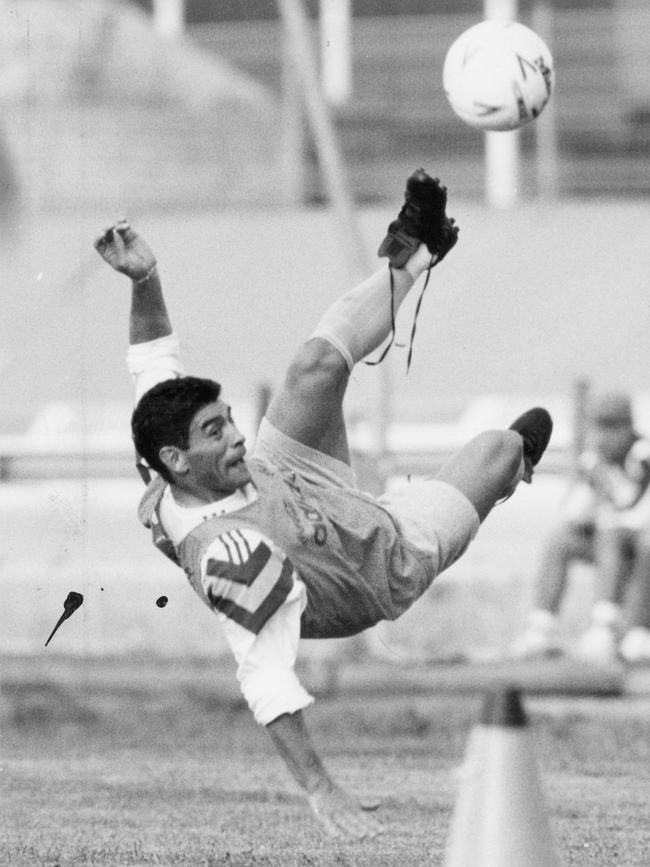
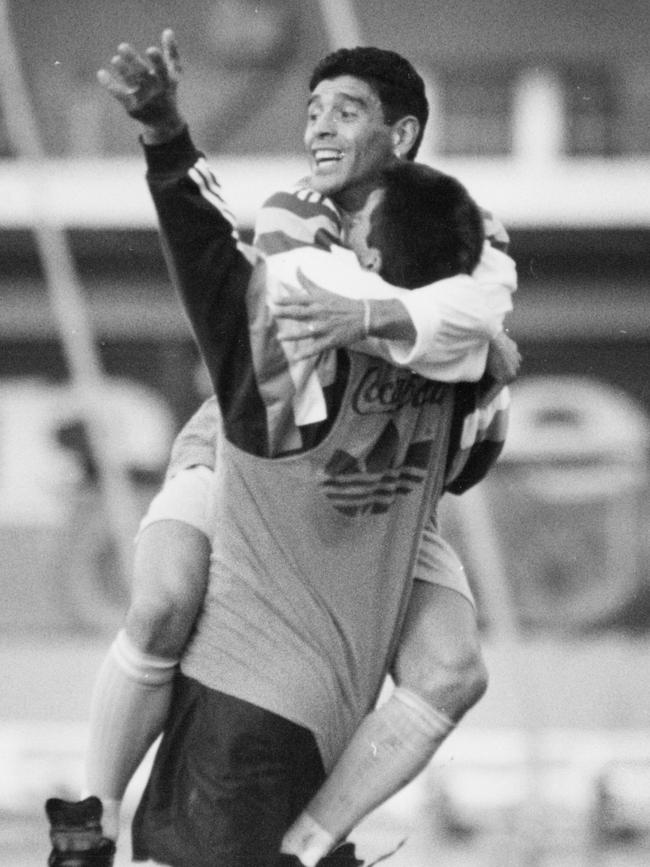
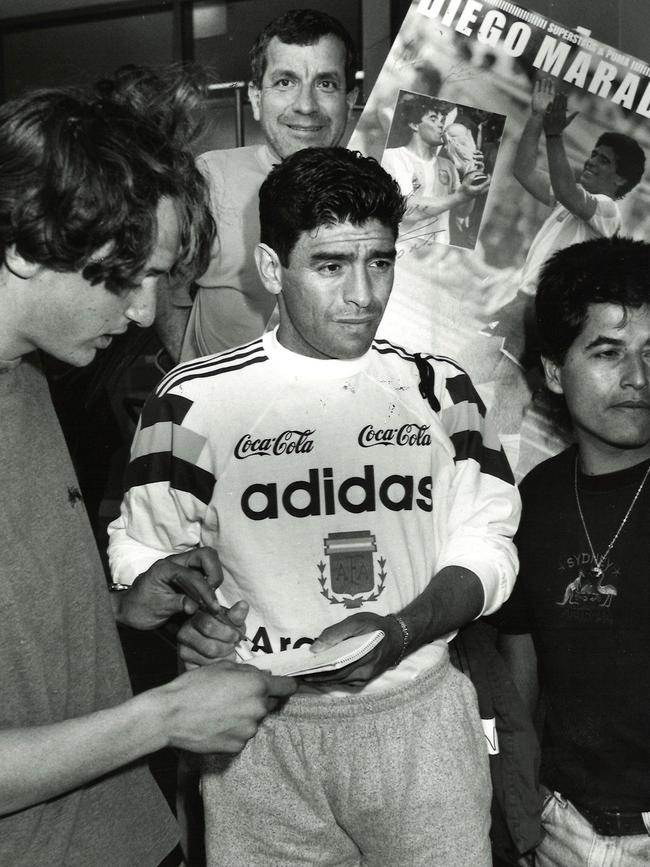
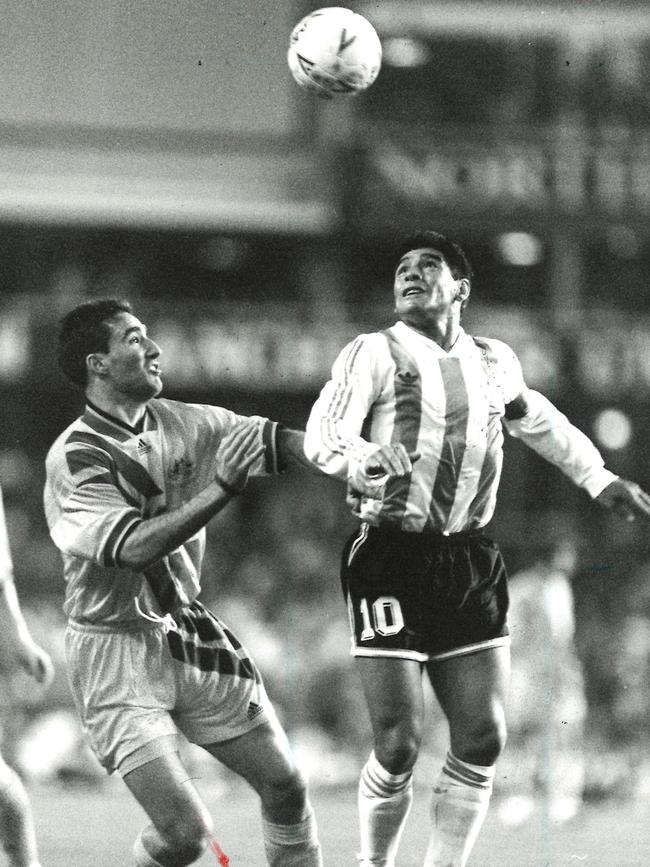
As Wade recounted: “I guess he had been tackled a lot harder by much, much better players than me!”
With that, the two sides ventured to Argentina for the return leg, which Argentina won 1-0 to secure passage to the World 1994 World Cup finals.
‘He often brought a nation to tears’
That World Cup signalled the end of Maradona’s international career after he failed a drugs test after the second game. He retired from football in 1997, playing his last game with his beloved Boca Juniors, the club he idolised as a kid.
The world game was poorer for the exit of a man whose outrageous skill and ability to make a football dance and sing mesmerised opponents and even teammates, as well as the millions and millions of fans who worshipped him.
Maradona was a soccer icon in and outside of his country of birth. Arguably the greatest player of all time, he was so loved and revered by his country people he often brought a nation to tears of joy.
But, the contrast between the footballer and the man off the field could not be more stark because Maradona was a flawed genius.
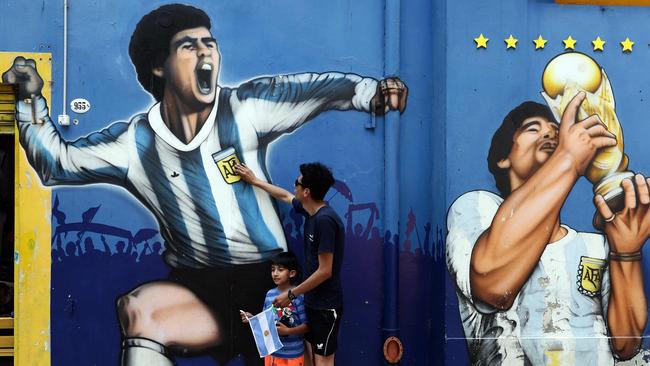
Born in the slums of Buenos Aires, Maradona and controversy walked hand-in-hand for almost the entirety of his career. Drug and alcohol addiction and his battles against weight cursed him but it was as if you could not have one, the sublime footballer, without the other.
There were several failed drug tests as a player as well as alleged connections with the Mafia during his successful time playing with Serie A club Napoli (Italy), where he led the club to two Serie A titles and a European trophy, and, of course, the infamous Hand of God goal he scored against England at the 1986 World Cup finals in Mexico City.
The good and bad of Maradona was seen in that game against England, and both sides arrived with four minutes of each other.
His first goal was clearly scored with his hand, punching it over the head of the goalkeeper before running away and cheekily celebrating as if nothing happened. But, just minutes later he scored arguably one of the greatest goals of all time. Gathering the ball just inside his own half, he glided past one player, then another, then another, and another before getting into the penalty area and slotting home his shot. It was pure genius.
History is littered with many stories of sportspeople who have made it to the pinnacle of world sport despite their flaws and frailties. Maradona, who never had the pure and clean cut image of the legendary Pele, was a perfect example.
His addiction to cocaine, his questionable entourage — people who did not know how to say no to him and simply sponged off his fame and fortune — and his legendary partying were there for all to see.
It begs the question: How much better Maradona would have been had drugs not been involved?
The man himself had no doubts in an interview with Argentina’s Tyc Sports in 2014: “I gave my opponents a big advantage due to my illness. Do you know the player I could have been if I hadn’t taken drugs?”
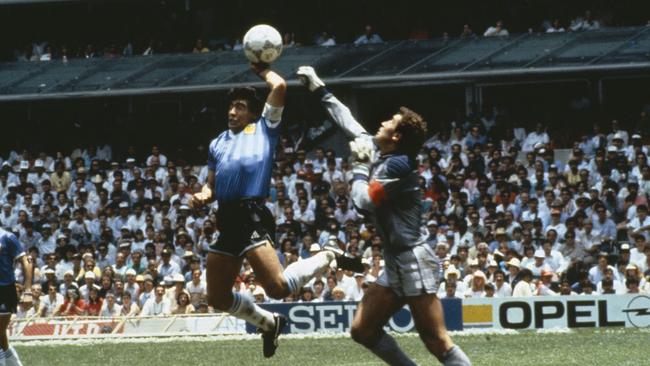
Of course, we will never know and it really doesn’t matter, especially for the hundreds of millions, especially in Argentina, who are in mourning the loss of their hero.
In an almost unprecedented year of pain and suffering through COVID-19, Argentina has been dealt a further hammer blow because Maradona meant everything to a nation that treats its football as its religion and Maradona as its God.
They celebrated and shared his career and successes with him and cried and despaired over his failings. But they never stopped loving him - and never will.
All up, Maradona played 491 club games and scored 259 goals. He played 91 times for his country, scoring 34 goals and is regarded as “single-handedly winning the 1986 World Cup” for them. He also coached the Argentina national team (2008-2010).
Now as the twitter handle God (@TheTweetOfGod) put it: “I just got My hand back.”
Ray Gatt is the former football writer for The Australian newspaper





